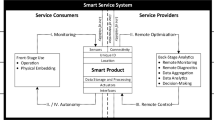Abstract
This chapter introduces the second part of the book “Managing Industrial Services.” An overview of the six practitioner contributions by Heidelberger Druckmaschinen, Schindler, John Deere, SKF, Siemens Mobility, and Kaeser is provided. Each contribution offers first-hand evidence of challenges and successful practices from manufacturers growing their (smart) service business.
Access provided by Autonomous University of Puebla. Download chapter PDF
Similar content being viewed by others
After having provided a comprehensive overview of the management of industrial services in general and of smart services in particular, we move our attention in this second part of the book to selected case studies from the real world. These cases shall help the reader to even better understand success factors and challenges when striving to make a business with services. All cases are written by contributors from practice to ensure authenticity and depth.
In the opening chapter, Heidelberger Druckmaschinen, a pioneer in the digitalization of services and supply, summarizes her journey from more than a decade in a comprehensive narrative culminating in the derivation of four takeaways covering the way to start the journey, namely using lean start-up teams and agile methods, putting customers in the center, mastering the technological challenges, and intentionally managing resistance. It is just stunning how Heidelberg managed to link over 13,000 customer presses in her IIoT platform, the Heidelberg Cloud.
Schindler, one of the leading global producers of elevators, escalators, and moving walkways—and for years a role model for an outstanding service orientation—focuses her contribution on the human factor and limits to a full digitalization approach. Based on a rich history and deep experience, the authors make clear that the future will not be shaped by technology alone but that there is a need for the purposeful combination of the latest digital technologies, sound processes, and human expertise. This chapter brings the human factor back to the center stage.
John Deere describes what was needed to enable her Dealer Network to successfully deliver smart services. In a comprehensive analysis, the author does not only provide insights into John Deere’s strategy and the role of after-sales service innovation in this context, but he also explains the organization, characteristics of the operating processes, cultural challenges, and the importance of visible management commitment and outstanding service quality. This chapter is an impressive account of the high maturity John Deere has already achieved on the way to a smart technology company but still building on highly reliable agricultural equipment.
SKF, a Swedish producer of bearings, adds an impressive story describing the way from an equipment manufacturer to a customer-centric provider of true solutions improving end-user productivity as well as energy efficiency. Along this journey, SKF changed her business model toward an “equipment-as-a-service” model. SKF provides insights not only into the successful use of artificial intelligence and condition monitoring but also describes hurdles they had to overcome.
Siemens Mobility adds a customer co-creation perspective as a means to drive and scale digital services to the book. An elaborated framework guides the co-creation process. The benefits of the application of this framework together with the customers, namely, customer-specific services, the engagement and commitment achieved by integrating the customer, better productivity and service quality, as well as reduced risks, heavily outweigh the challenges that are nevertheless also described in this chapter.
Part II concludes with the case of Kaeser, a producer of compressed air stations. The author describes the application of a digital twin for the automated planning, design, control, and analysis of these air stations. It is crucial to think this through over the whole life cycle of the compressors. The added value, if applied correctly, is considerable.
Author information
Authors and Affiliations
Corresponding author
Editor information
Editors and Affiliations
Rights and permissions
Copyright information
© 2021 The Author(s), under exclusive license to Springer Nature Switzerland AG
About this chapter
Cite this chapter
Friedli, T., Osterrieder, P. (2021). Editorial to Managing Industrial Services: Insights from Practice. In: Friedli, T., Osterrieder, P., Classen, M. (eds) Managing Industrial Services. Management for Professionals. Springer, Cham. https://doi.org/10.1007/978-3-030-72728-4_11
Download citation
DOI: https://doi.org/10.1007/978-3-030-72728-4_11
Published:
Publisher Name: Springer, Cham
Print ISBN: 978-3-030-72727-7
Online ISBN: 978-3-030-72728-4
eBook Packages: Business and ManagementBusiness and Management (R0)




